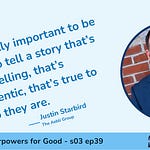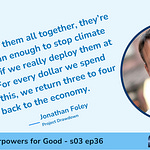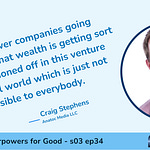When Main Street Meets Superpowers: Building Community Through Localism, Crowdfunding, and Collaboration
Each month, I have the genuine privilege of sitting down with my friend and colleague Jen Risley, editor of The Main Street Journal, for a conversation that bridges our shared passion for impact, innovation, and community-rooted change. Our most recent dialogue was no exception—it was a deeply thoughtful exchange exploring the intersections of decentralization, localism, and the real power of community-centered finance.
And this month’s chat brought a bonus: the announcement of Main Street Journal’s most-read issue to date, “A Localism Manifesto.” It’s an extraordinary piece that’s resonating not only with Jen’s readers but now across the broader Substack ecosystem. If you haven’t read it yet, consider this your personal invitation.
But beyond just catching up on what’s new in our respective publications, this conversation highlighted something more powerful: the way our two newsletters—Main Street Journal and Superpowers for Good—complement and enrich each other. So today, I’d like to recap our exchange, share some exciting announcements, and invite you to subscribe to both newsletters for the full scope of this evolving conversation around community, capital, and change.
A Localism Manifesto: Decentralization with Heart
Jen opened our chat by highlighting the incredible traction “A Localism Manifesto” has gained since its release on July 10. Penned with contributions from Paul Spinrad and Michael H. Shuman, the manifesto doesn’t just explore the theoretical underpinnings of decentralization—it invites community members to shape its next iteration. That’s not just content; that’s co-creation.
For Jen, the concept of decentralism was initially daunting—especially coming from New Hampshire, where the libertarian Free State Movement has made headlines. But the manifesto reimagines decentralization as a tool for building resilient, equitable communities, not just a political stance. “There’s a lot of real value in that position,” she said, and I wholeheartedly agree.
Our conversation touched on the risks of relying solely on government solutions—particularly at the federal level. While I’ve always believed in the potential for good in government, I also see firsthand the limits and bureaucracy that can get in the way. As I shared with Jen, I once had five different people at the California DMV mistakenly insist I needed a smog test for my electric vehicle. (Spoiler: I didn’t.)
This is exactly why Main Street Journal’s work is so important. It offers grounded, accessible pathways for rebuilding economic systems from the bottom up—starting on our very own Main Streets.
Decent Tuesday, Anarchy, and the Power of Language
We also celebrated the addition of Paul Spinrad to the Main Street Journal team. Paul, one of the early champions of the 2012 JOBS Act that enabled today’s investment crowdfunding landscape, is helping to lead a new series called “Decent Tuesday.” The name itself is a clever double entendre—Decent, as in ethical, and Descent, as in decentralization.
Paul’s launch column tackled a bold topic: anarchy. Not the violent imagery we might typically associate with the term, but anarchy in the truest sense of community self-governance and mutual aid. It’s a provocative frame, and Paul’s thoughtful treatment brings it firmly into the realm of community-led development.
As someone who has seen both the power and pitfalls of government, I find these discussions invaluable. They sharpen our thinking, challenge our assumptions, and remind us that even controversial ideas can have a role in shaping a better world—especially when led by voices like Paul’s and platforms like Jen’s.
Jenny Kasson’s Crowdfunding Campaign: A Case Study in Action
Jen was also inspired by my recent interview with Jenny Kassan—another pillar in our space—who is leading an equity crowdfunding campaign on Small Change to finance a transformative community real estate project in Baltimore.
Jenny’s campaign isn’t just about raising capital. It’s a real-time case study in how local investing, ecosystem thinking, and community ownership come together. The project will create furnished rental spaces with flexible terms (think: part Airbnb, part long-stay apartments) and community-oriented ground floor uses. It’s a blend of economic development and social impact that’s both inspiring and practical.
Jen pointed out how Jenny is also exploring complementary tools like time banking. As she noted, “It takes a lot more to create an ecosystem of local investing.” That insight captures the holistic nature of what we’re building across our platforms: sustainable, inclusive systems that elevate everyone—not just investors or entrepreneurs.
From SuperCrowdLA to SuperCrowd25
In that spirit, I shared my own exciting news: the release of our new book, The Big Ideas That Lit Up SuperCrowdLA. It’s a curated, refined distillation of the talks and insights from our recent SuperCrowdLA conference—organized not as a transcript, but as a harmonized narrative built with the help of AI and a whole lot of human editing.
This project was a joy to create, and I learned so much in the process. You can get it now as an eBook, paperback, hardcover, or audiobook—whatever format suits your learning style.
We also previewed SuperCrowd25, our fourth annual virtual summit on impact crowdfunding, streaming live across Substack and social media August 21–22. It’s free to attend, but our $25 VIP package adds access to exclusive networking opportunities, a permanent LinkedIn group, bonus webinars, and speaker handouts. It’s the best $25 you’ll spend this year if you’re building or funding impact-driven ventures.
And yes—if the new book resonates, we just might release a SuperCrowd25 book, too!
Subscribe, Support, and Build With Us
At the end of the day, Main Street Journal and Superpowers for Good are two sides of the same coin. Jen and I are championing different facets of the same movement: one that values people over profits, community over corporations, and action over apathy.
So if you’ve enjoyed the ideas in this piece, I have two invitations for you:
Subscribe to both newsletters.
We’re each doing our best work on Substack—and getting both perspectives will give you a richer, more complete view of this growing ecosystem of changemakers.Become a paid subscriber if you can.
Your support allows us to keep doing this work—and unlocks bonus content, community, and tools that help you take your own next step, whether that’s launching a campaign or building a stronger local economy.
We truly are better together. Let’s keep learning, building, and lifting each other up—one newsletter, one campaign, and one Main Street at a time.













